|
What’s in a Statue?
The Downfall of Icons, and Lately of Mohandas Gandhi
Part-I
Vinay Lal
First of two parts of The Desecration of a Statue: Gandhi and Race
A month into the national civil uprising that has shaken the United States, the rage of common people, and doubtless their own sense of social justice, has led to many outcomes—some with precedent, some without, and some on a scale never witnessed before. The looting of the first few days received outsized attention from the press and managed, in some respects, to divert attention from the much larger and well-organized nonviolent protests that were far more characteristic of the demonstrations precipitated by the brutal killing of George Floyd.
The United States entered about two weeks ago into a different phase of the struggle in the mode of the spectacular. Statues of Confederate generals, often astride horses—for that is what generals did in those days—have been lassoed off their pedestals; other Confederate monuments have been defaced; and some have been removed by city or local authorities in the stealth of the night. These statues—most prominently of Jefferson Davis, President of the Confederacy, and Robert E. Lee, who commanded the Army of Northern Virginia—have drawn the ire of protestors before, and the “Unite the Right” Rally of 2017 in Charlottesville, Virginia, became the occasion for a renewed demand for their removal as eternal symbols of the subjugation and humiliation of black people. What could not be achieved before has evidently been achieved this year as reports continue to come in of the destruction, removal, and vandalization of these statues. But it is not only these symbols of the Confederacy, which itself dared the American Republic to extinguish slavery and struggled to retain “a way of life” whose justification was sought in the Bible, in history, in Social Darwinism, and simply in the pleasure and profit that some men derive from exploitation, that have been uprooted in the last fifteen to twenty days.
This time, the outrage of the protestors has found other targets, among them Christopher Columbus, with whom the whole sordid story of European genocide, slavery, and barbarism in the Americas commences. Statues of Columbus have been vandalized or removed in Virginia, Texas, New Jersey, and Minnesota, and others will surely fall or be removed in the days ahead. What yet distinguishes even more the present outrage is that statues have been felled in other parts of the world. The statue in Antwerp of the butcher of the Congo, King Leopold II of Belgium, who ran an area in central Africa that was 75 times the size of his native Belgium as his personal fiefdom, and whose henchmen may have orchestrated the death of around 10 million Africans, was set fire to and has since been removed. In what is perhaps the most visceral display of the anger directed at the memorials which stand forth as testimony to the mass enslavement of Africans, the statue of the 17th century slave trader Edward Colston in Bristol, Britain, was toppled by protestors, rolled through the streets, and finally dumped into Bristol Harbor. The protestors who toppled the statue had the good sense to tie its hands and feet—if only to signify the manner in which African slaves were caged, denied their freedom, bound to servitude, and literally rendered immobile during that long journey on the slave ship known as the Middle Passage.
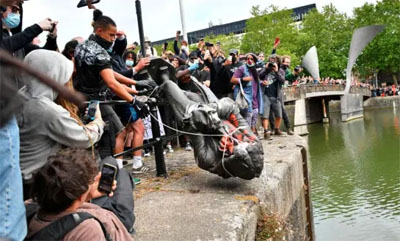
The statue of slave-trader Edward Colston being dumped into Bristol Harbor, England. Source: cnn.com
Much greater icons than Jefferson Davis or Robert Lee have taken a beating at the hands of protestors. The day before yesterday, protestors were thwarted in their attempt to bring down the equestrian statue of Andrew Jackson, the seventh President of the United States whose face adorns the $20 bill. On many previous occasions, Trump has declared his unqualified admiration for Jackson, though at least once the remarks of the present incumbent of the White House appeared to suggest that he thought that Jackson might still be alive! Jackson’s notoriety among liberals stems principally, though not solely, from his policy—encapsulated in the Indian Removal Act of 28 May 1830—that led to the removal of the Cherokees to west of the Mississippi River, though he also enslaved hundreds of African Americans. This forced resettlement of thousands of Native Americans, known as the “Trail of Tears”, might be described as an act that was critical in sealing the fate of all American Indians, not only the Cherokees. Though some were critical of Jackson’s worldview even at the time, he himself remained thoroughly unrepentant: as he put it in his second annual message to Congress, “What good man would prefer a country covered with forests and ranged by a few thousand savages to our extensive Republic, studded with cities, towns, and prosperous farms, embellished with all the improvements which art can devise or industry execute, occupied by more than 12,000,000 happy people, and filled with all the blessings of liberty, civilization, and religion?”
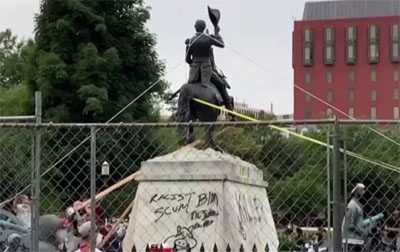
Protestors attempt to bring down the statue of Andrew Jackson at Lafayette Square, Washington, DC. Source: ABC News. The police intervened: 23 June 2020.
But matters have now gone beyond Jefferson and Washington. There is outrage in London, for instance, over the desecration of the statue of Winston Churchill, the war-time Prime Minister of Britain who came to be cast as the last man standing between barbarism and civilization. I have nothing to offer, he said, “but blood, sweat and tears”, and in politically conservative circles, and I suspect in some beyond that too, he is viewed with utter veneration as the gritty political leader who led Britain to a decisive triumph over Nazi Germany. In anti-colonial circles, however, Churchill has long had an altogether different and even odious reputation as someone who was racist to the core. Just precisely how he was a racist is a question that must be treated with diligence, something not possible within the confines of this essay, but there is little doubt that he persistently adhered to the view that Africans and Indians, among others, were incapable of exercising responsible self-government. He was scarcely alone in holding to this view. Growing up in India, I came to learn of him as the obdurate and relentless foe of Indian independence, and as someone who despised Mohandas Gandhi: as he put it rather infamously, on the eve of the Indian leader’s negotiations with the Viceroy for Indian self-representation, it was “alarming and also nauseating to see Mr. Gandhi, an Inner Temple lawyer, now become a seditious fakir of a type well known in the East, striding half-naked up the steps of the Viceregal Palace, while he is still organizing and conducting a defiant campaign of civil disobedience, to parley on equal terms with the representative of the King-Emperor.” For many years, while being intensely troubled by Churchill’s outlook, I also marveled at his enviable command over the English language.
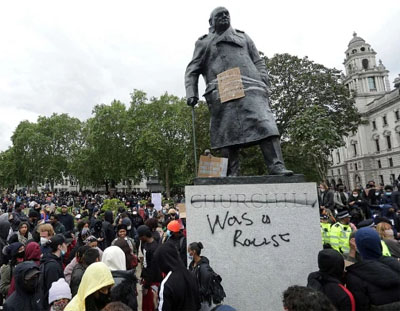
Statue of Winston Churchill outside Parliament Square, London, 7 June 2020. Source: https://www.dailymail.co.uk/news/article-8398909/Defiant-Black-Lives-Matter-protestor-says-desecrated-Churchills-statue.html. The masked BLM protestor who defaced it explains in a short video why he did so; the video is at the same source.
It is thus all the more ironical that even the statue of Mohandas Gandhi has not been spared. The desecration of his statue in the American capital—paint was sprayed over it and it appears to have been partially defaced—will seem inexplicable, perhaps some form of collateral damage in the heat of the moment as protestors went from one site to another, to the hundreds of millions who know of him only as the architect of Indian freedom and as the principal exponent of the idea of nonviolent resistance. Gandhi may have been reduced to a set of clichés, quotations adorned on mugs, T-shirts, posters, billboards, and car stickers, but it is instructive that among the many aphorisms attributed to him there is famously this one: “an eye for an eye will make the whole world blind”. If I may use the anodyne language that characterizes the remarks of corporate managers, liberal politicians, and well-intentioned university administrators, most “good people” everywhere are bound to feel horrified that the statue of no lesser a person than the Mahatma, ‘the Great Soul’, should have been vandalized. The American Ambassador to India, Ken Juster, seems to have been expressing precisely these sentiments when he tweeted with an Indian audience in mind, “So sorry to see the desecration of the Gandhi statue in Wash, DC. Please accept our sincere apologies. Appalled as well by the horrific death of George Floyd & the awful violence & vandalism.”
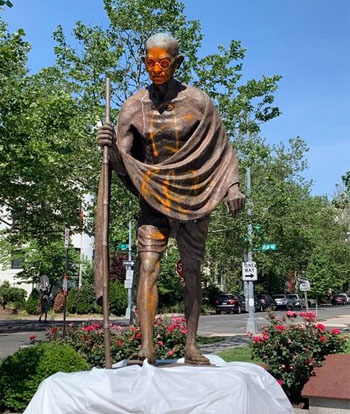
Gandhi’s statue in Washington, I might add, is no ordinary statue. It is not its aesthetic brilliance that distinguishes it, even as it is pleasing to the eye, but rather its location in the nation’s capital, a space reserved, with but a handful of exceptions, to commemorate the lives of those Americans who are deemed to have been decisive in shaping the nation’s history and endowing it with greatness. Indeed, the placement of statues and memorials in Washington is no easy matter, subject to immense bureaucratic hurdles, and falls under the jurisdiction of the US Congress itself; and Ambassador Juster’s apology must be read not only as an expression of atonement for the country’s inability to safeguard the statue of a person associated the world over with the idea of nonviolence but as a necessary diplomatic gesture.
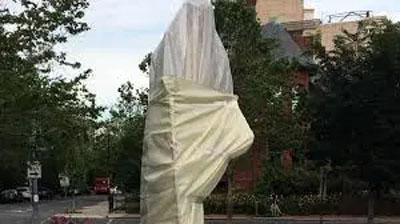
However, as I shall suggest in the forthcoming part, there is a more complex politics underlying the desecration of Gandhi’s statue, which has followed the path to which Gandhi himself has been confined by some: cold storage.
(to be continued)
[Vinay Lal is Professor of History and Asian American Studies at UCLA. He writes widely on the history and culture of colonial and modern India, popular and public culture in India, historiography, the politics of world history, the Indian diaspora, global politics, contemporary American politics, the life and thought of Mohandas Gandhi, Hinduism, and the politics of knowledge systems.]
Originally published as much shorter piece under the title of “The Desecration of a Statue: Gandhi and Race” on June 15, 2020, at abpliv.org.
Courtesy: https://vinaylal.wordpress.com/
Back to Home Page
Frontier
Jun 27, 2020
Prof. Vinay Lal VLAL@HISTORY.UCLA.EDU
Your Comment if any
|
